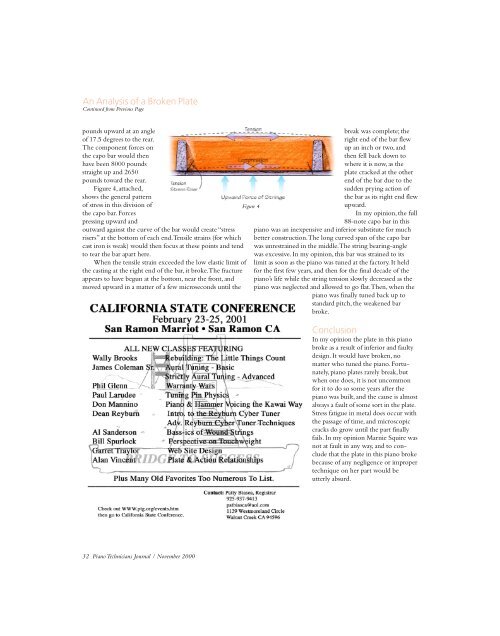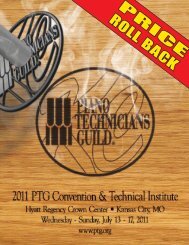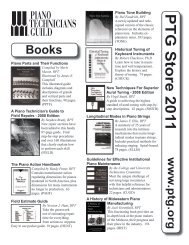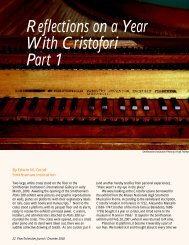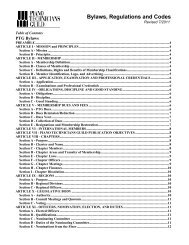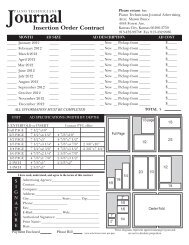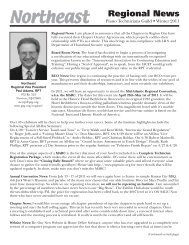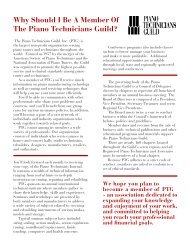Download PDF - Piano Technicians Guild
Download PDF - Piano Technicians Guild
Download PDF - Piano Technicians Guild
You also want an ePaper? Increase the reach of your titles
YUMPU automatically turns print PDFs into web optimized ePapers that Google loves.
An Analysis of a Broken Plate<br />
Continued from Previous Page<br />
pounds upward at an angle<br />
of 17.5 degrees to the rear.<br />
The component forces on<br />
the capo bar would then<br />
have been 8000 pounds<br />
straight up and 2650<br />
pounds toward the rear.<br />
Figure 4, attached,<br />
shows the general pattern<br />
of stress in this division of<br />
the capo bar. Forces<br />
pressing upward and<br />
outward against the curve of the bar would create “stress<br />
risers” at the bottom of each end. Tensile strains (for which<br />
cast iron is weak) would then focus at these points and tend<br />
to tear the bar apart here.<br />
When the tensile strain exceeded the low elastic limit of<br />
the casting at the right end of the bar, it broke. The fracture<br />
appears to have begun at the bottom, near the front, and<br />
moved upward in a matter of a few microseconds until the<br />
32 <strong>Piano</strong> <strong>Technicians</strong> Journal / November 2000<br />
Figure 4<br />
break was complete; the<br />
right end of the bar flew<br />
up an inch or two, and<br />
then fell back down to<br />
where it is now, as the<br />
plate cracked at the other<br />
end of the bar due to the<br />
sudden prying action of<br />
the bar as its right end flew<br />
upward.<br />
In my opinion, the full<br />
88-note capo bar in this<br />
piano was an inexpensive and inferior substitute for much<br />
better construction. The long curved span of the capo bar<br />
was unrestrained in the middle. The string bearing-angle<br />
was excessive. In my opinion, this bar was strained to its<br />
limit as soon as the piano was tuned at the factory. It held<br />
for the first few years, and then for the final decade of the<br />
piano’s life while the string tension slowly decreased as the<br />
piano was neglected and allowed to go flat. Then, when the<br />
piano was finally tuned back up to<br />
standard pitch, the weakened bar<br />
broke.<br />
Conclusion<br />
In my opinion the plate in this piano<br />
broke as a result of inferior and faulty<br />
design. It would have broken, no<br />
matter who tuned the piano. Fortunately,<br />
piano plates rarely break, but<br />
when one does, it is not uncommon<br />
for it to do so some years after the<br />
piano was built, and the cause is almost<br />
always a fault of some sort in the plate.<br />
Stress fatigue in metal does occur with<br />
the passage of time, and microscopic<br />
cracks do grow until the part finally<br />
fails. In my opinion Marnie Squire was<br />
not at fault in any way, and to conclude<br />
that the plate in this piano broke<br />
because of any negligence or improper<br />
technique on her part would be<br />
utterly absurd.


